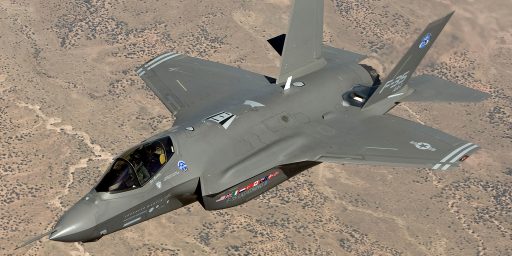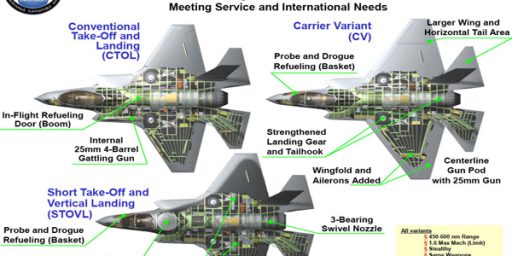The F-35 Engine Nobody Wants Is Back
Despite having been killed last year, the effort by some defense lobbyists for a second engine for the F-35 Joint Strike Fighter simply refuses to die:
WASHINGTON — The Department of Defense has officially canceled a contract for a General Electric-developed F-35 Joint Strike Fighter. Both the House and the Senate have blocked funding for it, arguing that one engine for one plane is enough.
Connecticut-based Pratt & Whitney won the original contract for one engine, while a GE-Rolls Royce alliance has been developing a second engine. The latter has become a symbol of government waste, and the White House has promised to veto any bill that funded the alternate program.
Yet the engine simply won’t die.
The House Armed Services Committee released its spending outlines for the coming fiscal year Tuesday, and the second engine is right back in.
The budget for the Air and Land Forces Subcommittee, chaired by Rep. Roscoe Bartlett (R-Md.), includes language that bars funding for engine unless “two options for such propulsion system are obligated or expended.”
“The fat lady hasn’t sung yet,” Lisa Wright, a spokeswoman for Bartlett, told HuffPost.
And the lobbyist money keeps flowing.







Now can we kill the rest of the aircraft?
Good thing those deficit hawks just took over the House. 😛
I think it’s for the best. Without a second engine, we might have to ground the entire fleet of F-35s if a major technical problem shows up with their existing engines.
Do we need the F-35 at all, let alone a second engine?
Brett — Don’t you think we need at least six different engines in case major technical problems show up in the first five?
The engine is made by GE. I guess it wouldn’t have anything to do with Obama jobs chief being the CEO of GE.
We do need the F-35 since the planes we’re using are getting up there in age (20+ years for most fighters now) and require lots of maintenance to sustain the flight hours needed to do training and combat operations.
I’m sorry, but which house controlled by which party wrote the budget? I think it starts with an R…
Yes, SH, because Obama controls the Republicans in the House.
Looks like G-E/RR could turn the engine development into a self-funded or at least partially government-funded program to create engines for future F-35 lots or even a new long-range bomber being planned. If that’s the case, the second engine does have some possible benefits for the future.
http://www.aviationweek.com/aw/generic/story_generic.jsp?channel=defense&id=news/awx/2011/05/03/awx_05_03_2011_p0-318342.xml&headline=Next%20Gen%20Bomber%20Linked%20To%20Self-Funded%20F136
@wr
Missing one grounding issue wouldn’t be surprising – it happened with the last wave of fighter jets (either F-16s or F-15s). Missing five would indicate major problems in the development process.
@Eric
Not to mention that they don’t guarantee air superiority anymore, and that’s not just about being able to shoot down enemy planes. Having total air superiority back in the 1980s and 1990s meant that other other countries usually didn’t even bother scrambling planes when in conflict with the US (the exception was Libya once), since they’d just be shot down.
People don’t understand what air superiority does for a military. To not have to worry about being attacked from the air is big for ground forces. Air defenses have gotten better since the legacy jets were introduce so the F-35, along with the F-22, will help take back that advantage.